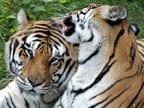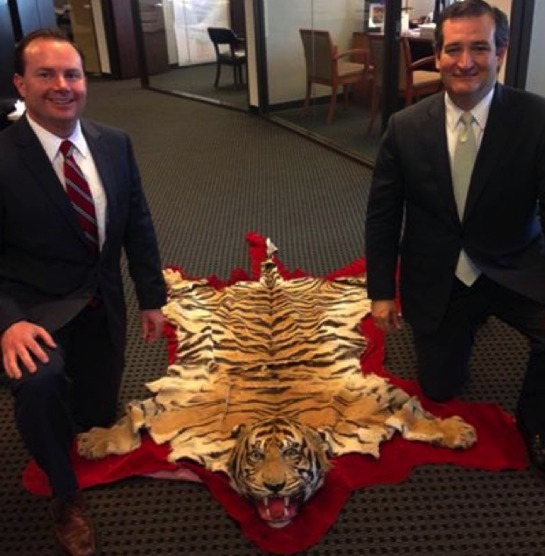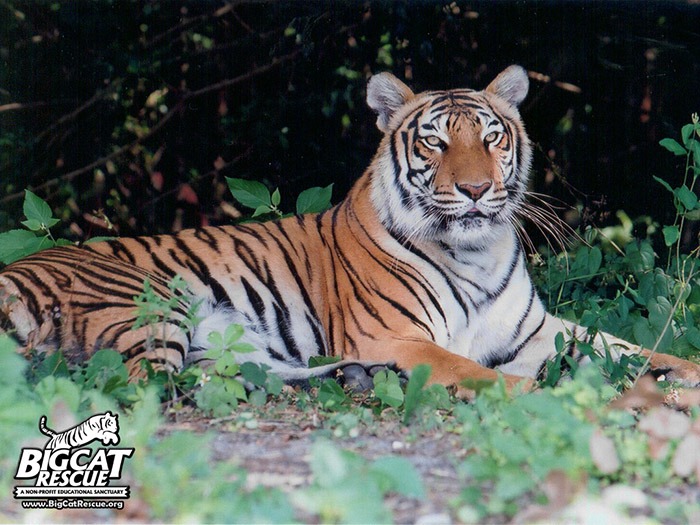We Believe Cub Petting Violates the Animal Welfare Act
These are the AWA sections (see bolded items) that we believe lion, tiger and leopard cub exhibitors are violating the most:
 Sec. 2.40 Attending veterinarian and adequate veterinary care [this section has basic language about providing adequate vet care, having a written Program of Veterinary Care, regular vet visits, daily observation of animals, etc.]
Sec. 2.40 Attending veterinarian and adequate veterinary care [this section has basic language about providing adequate vet care, having a written Program of Veterinary Care, regular vet visits, daily observation of animals, etc.]
Sec. 2.131 Handling of animals.
(a) All licensees who maintain wild or exotic animals must demonstrate adequate experience and knowledge of the species they maintain.
(b)(1) Handling of all animals shall be done as expeditiously and carefully as possible in a manner that does not cause trauma, overheating, excessive cooling, behavioral stress, physical harm, or unnecessary discomfort.
(2)(i) Physical abuse shall not be used to train, work, or otherwise handle animals.
(ii) Deprivation of food or water shall not be used to train, work, or otherwise handle animals; Provided, however, That the short-term withholding of food or water from animals by exhibitors is allowed by these regulations as long as each of the animals affected receives its full dietary and nutrition requirements each day.
(c)(1) During public exhibition, any animal must be handled so there is minimal risk of harm to the animal and to the public, with sufficient distance and/or barriers between the animal and the general viewing public so as to assure the safety of animals and the public.
(2) Performing animals shall be allowed a rest period between performances at least equal to the time for one performance.
(3) Young or immature animals shall not be exposed to rough or excessive public handling or exhibited for periods of time which would be detrimental to their health or well-being.
(4) Drugs, such as tranquilizers, shall not be used to facilitate, allow, or provide for public handling of the animals.
(d)(1) Animals shall be exhibited only for periods of time and under conditions consistent with their good health and well-being.
(2) A responsible, knowledgeable, and readily identifiable employee or attendant must be present at all times during periods of public contact.
(3) During public exhibition, dangerous animals such as lions, tigers, wolves, bears, or elephants must be under the direct control and supervision of a knowledgeable and experienced animal handler.
(4) If public feeding of animals is allowed, the food must be provided by the animal facility and shall be appropriate to the type of animal and its nutritional needs and diet.
(e) When climatic conditions present a threat to an animal’s health or well-being, appropriate measures must be taken to alleviate the impact of those conditions. An animal may never be subjected to any combination of temperature, humidity, and time that is detrimental to the animal’s health or well-being, taking into consideration such factors as the animal’s age, species, breed, overall health status, and acclimation.
It is impossible for inspectors to enforce these rules because:
 Sec. 2.40 Attending veterinarian and adequate veterinary care [this section has basic language about providing adequate vet care, having a written Program of Veterinary Care, regular vet visits, daily observation of animals, etc.]
Sec. 2.40 Attending veterinarian and adequate veterinary care [this section has basic language about providing adequate vet care, having a written Program of Veterinary Care, regular vet visits, daily observation of animals, etc.]
The PVC is a 4 page document that lists the “attending veterinarian” but there are no requirements that the vets perform any standardized care. An annual visit would constitute a “regular vet visit” but would be far less than adequate and there is no requirement that the “daily observation” of animals be done by anyone who has special training, nor is there any required record keeping of the observations.
Sec. 2.131 Handling of animals.
(a) All licensees who maintain wild or exotic animals must demonstrate adequate experience and knowledge of the species they maintain.
There is no formal training required and no way to verify whether or not the licensee knows what they are doing. A simple case in point is that Tony, the truck stop tiger, was cared for daily by whoever was manning the gas station.
(b)(1) Handling of all animals shall be done as expeditiously and carefully as possible in a manner that does not cause trauma, overheating, excessive cooling, behavioral stress, physical harm, or unnecessary discomfort.
Breeding big cats in order to take their cubs for photo ops and pay-to-play sessions does cause behavioral stress and trauma to the mother, who is then usually bred back immediately to keep up the supply of cubs coming. Big cats are only designed to have cubs every 2 or 3 years because they spend that much time raising, bonding and grooming their offspring for life in the wild. The cubs suffer trauma, behavioral stress, physical harm, and unnecessary discomfort because their natural mothers would be ever-present, comforting and protecting them whereas their human handlers often keep them in pet carriers and only pull them out to feed, clean or use as a money making prop. Many cubs die from the rough handling, the improper storage of the formula (ie: leaving it out and subjecting it to bacteria) and then suffer a cruel and very uncomfortable death as a result.
As for the handling of juvenile and adult exotic cats, they are often subjected to all of the prohibited cruelties listed because they are apex predators being forced to live in overcrowded, un natural and far too small environments. Big cats are designed to roam habitats that are measured in square miles, not square feet. USDA inspectors typically only visit once a year. There is no way they would see the violations that are typical to the trade such as using electric prods to move the cats, whips and bats to beat them, hours on end in the back of unventilated trucks and the suffering that accompanies untreated wounds and a diet that is often composed of road kill and animals who died of disease that cannot be used in human food production.
(2)(i) Physical abuse shall not be used to train, work, or otherwise handle animals.
Since USDA does not do undercover investigations, they would never see the violations that are typical to the trade such as using electric prods to move the cats, whips to train them, hours on end in the back of unventilated trucks. When the USFWS did an undercover investigation called Operation Snow Plow they did find egregious violations that would have been USDA violations as well, such as cutting up tigers for human consumption of their meat.
(ii) Deprivation of food or water shall not be used to train, work, or otherwise handle animals; Provided, however, That the short-term withholding of food or water from animals by exhibitors is allowed by these regulations as long as each of the animals affected receives its full dietary and nutrition requirements each day.
Many facilities are so poorly funded that the cats are only fed once or twice a week, but USDA has no way to know if that is the case because they do not do undercover investigative work and are relying entirely on the owner’s word as to when cats are fed and what they are fed. As long as captive cats can be fed road kill and “downer” animals there is no way to know what parasites, toxins or diseases they may be contracting. The notion that owners who feed this kind of diet, and sparsely at that, would not withhold food or water for the purpose of training is absurd. USDA isn’t around to monitor the main diet, nor the training of the animals, thus it is impossible for them to catch the violators in the act.
(c)(1) During public exhibition, any animal must be handled so there is minimal risk of harm to the animal and to the public, with sufficient distance and/or barriers between the animal and the general viewing public so as to assure the safety of animals and the public.
This has been vague enough to result in 681 exotic cat incidents, including killings, maulings and escapes in the U.S. just since 1990. The USDA’s own Big Cat policy states that cubs under the age of 8 weeks may not be used for contact and that a leash is not a sufficient barrier. The USDA appellate case USDA vs Palazzo ruled that cubs over the age of 12 weeks cannot be used for contact. Yet, the Office of the Inspector General found in their audit of USDA that these rules, and others, were not known nor enforced by many of their inspectors. The most common interpretation by USDA inspectors has been that if someone was hurt, then there was “insufficient distance and/or barriers” and if no complaint was filed then no rule was broken. A case in point is that at GW Exotic Animal Park there are no barricades around some big cats where the public is taken right next to the cage and cubs that are both over and under the legal age have been used for cub petting and documented on video, and in formal complaints by witnesses, but as of 12/24/11 no citation has been documented for the violations.
(2) Performing animals shall be allowed a rest period between performances at least equal to the time for one performance.
Since USDA inspectors would rarely even see such exhibits, and even if they did would only be there for a few minutes, there is no way for them to see that cubs are being used over long weekends, all day long. In some mall and fair events the cubs are on display and awakened for use countless times a day over a full week. One exhibitor claimed he could make $23,000 in a weekend. If he had 4 cubs and worked 10 hour days (mall hours) that would mean waking a cub up 144 times a day to make that kind of money at $20 a photo. That works out to waking the cub just about every 5 minutes.
(3) Young or immature animals shall not be exposed to rough or excessive public handling or exhibited for periods of time which would be detrimental to their health or well-being.
Just like infant children, exotic cat cubs should be mostly sleeping and nursing during their early weeks of life. The fact that just one cub user was known to have had 23 tiger cubs die in 2010 is a strong indicator of the deleterious effects of rough or excessive public handling. It is nearly impossible for USDA to catch a breeder with a dead cub, much less with 23 of them. At this writing 12/24/11 the USDA has failed to take any public action on behalf of those dead cubs. The number of cubs who are suffering the same rough or excessive public handling at other facilities, and who are dying and being quietly disposed of is likely to be staggering.
Just the act of taking a cub from their mother and her natural milk and instincts to protect them and subject them to living in pet carriers and being fed cow’s milk or goat’s milk is detrimental to their health and well-being.
(4) Drugs, such as tranquilizers, shall not be used to facilitate, allow, or provide for public handling of the animals.
In nearly 20 years of rescuing big cats, I have not once heard of a USDA inspector testing the blood or urine of a big cat on display to find out if the cat was drugged. On the contrary though, I have witnessed and reported numerous counts of adult big cats, exhibiting obvious signs of being drugged, such as inability to rouse the cat and the dazed look and head bobbing that often accompanies sedation. To my knowledge no exhibitor has ever been cited for drugging a cat to use them for display. Since we know it happens, it would mean that either inspectors are not well trained enough to know or that they turn a blind eye.
(d)(1) Animals shall be exhibited only for periods of time and under conditions consistent with their good health and well-being.
See all of the above for why exhibiting cubs for use as photo and pay-to-play props would always be a violation of this rule. If you have ever seen a big cat pacing, eyes not focusing, but rather appearing not to be seeing at all, then you have seen an animal who is being exhibited under conditions that are not consistent with their good health and well-being. Just about any zoo will be full of cages of cats pacing in this stereotypic manner. There is a clear difference in a cat who is focused on dinner coming, or a small child they would like to maul because their gaze is intent on the object of their attention. Their pacing is a sign of their frustration at not being able to be free of their captivity to pursue the food or child, but is not the gut wrenching pacing of a cat who has given up all hope, who paces back and forth in a well worn pattern and whose eyes are open but not “seeing.”
(2) A responsible, knowledgeable, and readily identifiable employee or attendant must be present at all times during periods of public contact.
Anyone who is both responsible and knowledgeable of exotic cats would not be allowing public contact. The fact that USDA would make it a rule that public contact can take place provided such a person is in charge illustrates that they wouldn’t know when the rule wasn’t being followed.
(3) During public exhibition, dangerous animals such as lions, tigers, wolves, bears, or elephants must be under the direct control and supervision of a knowledgeable and experienced animal handler.
Pound for pound a tiger is 12 times stronger than a man. Tigers usually weigh 300-500 lbs making even the smallest tiger 24 times stronger than a man. Unless the big cat is in a cage from which they cannot escape, they are never under the direct control of a handler.
(4) If public feeding of animals is allowed, the food must be provided by the animal facility and shall be appropriate to the type of animal and its nutritional needs and diet.
In most cases these public feedings are done by allowing the public to hold a baby bottle full of cow’s milk or goat’s milk for the lion or tiger cub. In addition to all of the spoilage issues of having milk set out for long periods of time, and the fact that dozens of people are wiping their noses, mouths and then touching the bottle, the contents of the bottle are not appropriate to the type of animal and its nutritional needs and diet. Tiger cubs need tiger milk. Lion cubs need lion milk. The only reason these cubs are being bottle fed on display by paying customers is because it is a money maker. The owners will usually say the mother “rejected” the cub but cubs are typically taken away at 3 days as a matter of course. In some cases captive cats will kill their young, but that occurs when a mother cat feels that conditions are so threatening to her and her young that she is better off to try again later in a better environment. There is a huge overabundance of captive big cats in the U.S. who are living in squalid and unsafe cages so there is no reason to be breeding more.
(e) When climatic conditions present a threat to an animal’s health or well-being, appropriate measures must be taken to alleviate the impact of those conditions. An animal may never be subjected to any combination of temperature, humidity, and time that is detrimental to the animal’s health or well-being, taking into consideration such factors as the animal’s age, species, breed, overall health status, and acclimation.
If a USDA inspector only shows up once or twice a year, how often will they be able to document animals who are being kept in extremes of temperature and humidity? Even if they do manage to catch a cat panting or shivering this is how the citation process works:
The inspector may cite a facility for “improper handling” in 2004, and again in 2005, and again in 2006, and again in 2007, and again in 2008, and again in 2009, and again in 2010, and again in 2011. Unless someone gets mauled or killed at the facility, it is never likely to amount to anything more than just a vague citation on their inspection. Public watchdogs, like Big Cat Rescue are not privy to the investigator’s notes, so we won’t be able to raise public awareness since the facts are being hidden. If someone does gets mauled or killed there may be an administrative hearing and USDA may toss in the citations for “improper handling” just in case nothing else sticks. The cases usually take a couple of years to be heard and then a couple of years going through the appellate courts and then may result in a fine. Most fines are nominal, but even the larger ones ($25,000) are considered by the breeders and dealers to just be the “cost of doing business.” In many cases the animals are dead before any justice is served.
Meanwhile it is extremely rare for a license to be suspended and even then it is usually only for a year or two and the people are right back at it. In most cases they just change the business name and start over with a clean slate. Because of this it isn’t in the USDA’s best interest to pursue cases because it costs them money and manpower they don’t have. The OIG and whistle blowers within USDA have stated that inspectors are dissuaded from reporting citations. When an abuser tells you that they have perfect USDA inspections, it really doesn’t mean much.






